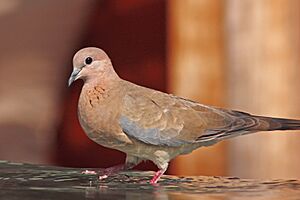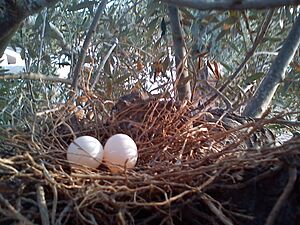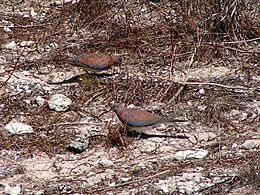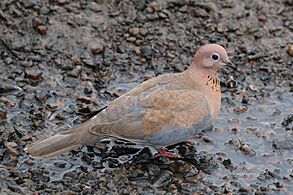Laughing dove facts for kids
Quick facts for kids Laughing dove |
|
|---|---|
 |
|
| S. s. cambayensis at Zighy Bay in the Musandam Peninsula, Oman | |
| Conservation status | |
| Scientific classification | |
| Genus: |
Spilopelia
|
| Species: |
senegalensis
|
| Synonyms | |
|
|
The laughing dove (Spilopelia senegalensis) is a small pigeon. It lives in Africa, the Middle East, South Asia, and Western Australia. In Australia, it started living in the wild after being released from Perth Zoo in 1898.
This small dove has a long tail. You can find it in dry, bushy areas and semi-desert places. Pairs of laughing doves are often seen looking for food on the ground. It is related to the spotted dove (Spilopelia chinensis). The spotted dove has a special white and black pattern on its neck. Other names for the laughing dove include laughing turtle dove, palm dove, and Senegal dove. In Asia, people often call it the little brown dove.
Contents
How Scientists Name Birds
Scientists give living things two-part names. This is called binomial nomenclature. It helps everyone around the world know which animal they are talking about.
In 1766, a Swedish scientist named Carl Linnaeus gave the laughing dove its first scientific name. He called it Columba senegalensis. He put it in the same group, or genus, as other pigeons.
For many years, the laughing dove was placed in the genus Streptopelia. Later, in 2001, scientists studied the birds' DNA. They found that the laughing dove and the spotted dove were very closely related. So, they moved them to a different genus called Spilopelia. This genus was first suggested by another Swedish scientist, Carl Sundevall, in 1873.
There are five main types, or subspecies, of laughing doves. They have small differences in their feathers and size:
- S. s. phoenicophila (Hartert, 1916) – Found from Morocco to northwest Libya.
- S. s. aegyptiaca (Latham, 1790) – Lives in the Nile Valley in Egypt.
- S. s. senegalensis (Linnaeus, 1766) – Also called the southern laughing dove. It lives in west Arabia, Socotra Island, and Africa south of the Sahara Desert.
- S. s. cambayensis (Gmelin, JF, 1789) – Found from east Arabia and east Iran to Pakistan, India, and Bangladesh.
- S. s. ermanni (Bonaparte, 1856) – Lives in Kazakhstan, north Afghanistan, and west China.
What the Laughing Dove Looks Like
The laughing dove is a slim pigeon with a long tail. It is usually about 25 cm (9.8 in) long. Its belly is pinkish-brown, and its head and neck have a purple tint. The lower part of its belly is a lighter, buff color.
Adult laughing doves have a special pattern on the sides of their neck. It looks like a checkered patch of reddish-brown and grey feathers. The top parts of the bird are brownish. There is a bluish-grey band along its wings. The back of the South Asian laughing doves is a plain dull brown.
African laughing doves (S. s. senegalensis and S. s. phoenicophila) have a bluish-grey rump and upper tail feathers. However, their neck and wing feathers have different shades. The S. s. aegyptiaca type is larger. Its head and neck are more reddish-purple, and its upper wing feathers are reddish-brown.
The tail feathers get shorter towards the end, and the outer ones have white tips. Male and female laughing doves look very similar. Young birds do not have the checkered neck markings. Their legs are red. Doves from drier areas tend to be paler in color.
The laughing dove's call sounds like a low, rolling chuckle. It goes croo-doo-doo-doo-doo and gets louder and softer.
Where Laughing Doves Live
This bird is very common and lives in many places. You can find it in bushy areas, dry farmland, and near where people live. They often become very comfortable around humans.
Their home range includes most of Africa south of the Sahara Desert. They also live in Saudi Arabia, Iran, Iraq, Afghanistan, Pakistan, and India. You can also find them in Cyprus, Israel, Lebanon, Syria, Jordan, the UAE, and Turkey. Some of these populations might have been brought there by people.
Laughing doves usually stay in one area. However, some groups might move around. For example, birds tagged in Gujarat, India, have been found 200 km north in Pakistan. Sometimes, tired birds have even landed on ships in the Arabian Sea. The laughing dove was brought to Perth, Australia, in 1889. Now, it lives all over Western Australia.
Behavior and Life Cycle
Laughing doves are usually seen in pairs or small groups. They rarely gather in very large numbers. However, bigger groups might form when they drink water in dry areas. Before drinking, small groups gather on trees near waterholes. Then, they fly to the water's edge. Like other pigeons, they can suck up water.
Laughing doves eat seeds that have fallen on the ground, mostly from grasses. They also eat other plant material and small insects like termites and beetles. They spend a lot of time on the ground, looking for food in grasslands and farms. Their flight is fast and straight. They flap their wings regularly and sometimes give a sharp flick, which is typical for pigeons.
Reproduction
When a male dove wants to attract a female, he bobs his head and coos. He might also peck at his own folded wings. This is a way to ask the female to mate. If the female accepts, she will crouch down and beg for food. The male might feed her a little before mating. Pairs of doves sometimes preen each other's feathers. Males also fly up into the air, clapping their wings above their backs. Then, they glide down in a gentle curve to show off.
Laughing doves can breed for a long time during the year in Africa. In Malawi and Türkiye, they can breed almost all year. In Zimbabwe, it's mainly from May to November. In Egypt and Tunisia, it's from February to June. In Australia, the main breeding season is from September to November.
The nest is a simple, flimsy platform made of twigs. They build it in a low bush, or sometimes in cracks or under the roofs of houses. Both parents help build the nest. The male brings the twigs, and the female arranges them.
The female lays two eggs, usually one day apart. Both parents take turns sitting on the eggs and feeding the young. Males spend more time incubating during the day. The eggs hatch after about 13 to 15 days. When predators come near the nest, the adult doves might pretend to be hurt. This helps to distract the predator and lead it away from the nest.
A pair of doves can raise many groups of young in the same nest. In Türkiye, one pair was seen raising seven groups! When the baby doves first hatch, they are helpless. Their parents feed them "crop-milk." This is a special liquid made in the parents' throat. The young doves grow quickly and leave the nest after about 14 to 16 days.
Sometimes, a bird called the Jacobin cuckoo lays its eggs in the nests of laughing doves in Africa.
Health and Predators
Laughing doves can sometimes get sick. In Australia, some wild doves have a virus that affects them. Several types of tiny lice can live on the laughing dove's feathers. A tiny blood parasite called Trypanosoma hannae has also been found in them.
Birds like the Southern grey shrike have been seen hunting adult laughing doves in northwestern India. In Africa, the lizard buzzard also preys on them. Some laughing doves in South Africa have a beak problem where the upper part grows too long.
Images for kids
-
Wild S. s. senegalensis, Rottnest Island, Western Australia
-
Female S. s. senegalensis, Gambia








